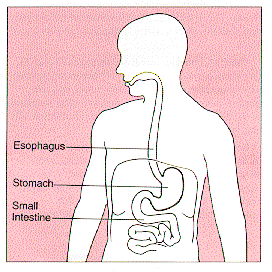Wikijunior:Human Body/Digestive System/Stomach
The stomach is a part of the digestive system. It is where food is stored and where digestion continues after food is chewed and swallowed.
What does the stomach look like?
editMany people think the stomach is near the belly button. However, it is really higher up. The stomach is behind the lower part of the ribs.
The stomach is a bag or pouch made of muscle. The stomach is a j-shaped organ. It is about the size of a grapefruit....
The stomach stretches when it is full of food.
It also has an exit and an entrance.
What are the parts of the stomach?
editAt the top of the stomach is a tube where food comes in from the esophagus. When you swallow, this tube opens so food can go in the stomach.
The stomach is made of muscle. These muscles help to break down food by mashing it into smaller pieces. The muscles also make waves pushing the food further down the digestive track. This is called peristalsis and happens from the esophagus all the way to the large intestine.
The stomach is lined with glands. These special cells make a liquid that is released into the stomach. This liquid is called gastric juice. The gastric juice has acid in it and helps break down or digest food.
The bottom part of the stomach is called the pyloric area. At the bottom of the stomach is another opening. This leads to the small intestine.
One of the most important parts of the stomach (and generally of the digestive system) is the bacterial fauna that populates it. Distinct to the specific environment, and part of a system that produces enzymes necessary to process some foods or optimize what can be extracted from what we ingest. A symbiotic (mutual beneficial) relation that is created and updated from birth, including the milk a baby gets from his mother.
What is the function of the stomach?
editThe stomach stores food and begins to digest it. It does this by using its muscles to crush food into smaller pieces. The stomach uses digestive enzymes and acids to break down food.
How does the stomach interact with other parts of the body?
editThe stomach does its job without you thinking about it. It is controlled by the nervous system. The nerves help tell you when to feel hungry. They also tell your stomach when to start making more chemicals for digestion.
The inner layer of the stomach has blood vessels in it. The blood supplies oxygen to the stomach so it can do its work.
Muscles in the stomach help move food through it. After the stomach has done its work, the food moves on to the small intestine.
How can you keep your stomach healthy?
editGood digestion begins with chewing. Chewing food well and eating slowly is good for your stomach.
Eat when you're hungry. Don't eat too much or too little food. Try to eat food that doesn't have too much fat or sugar. Include vegetables and fruit in your diet. If you eat something that often makes your stomach hurt or feel bad, avoid that food.
